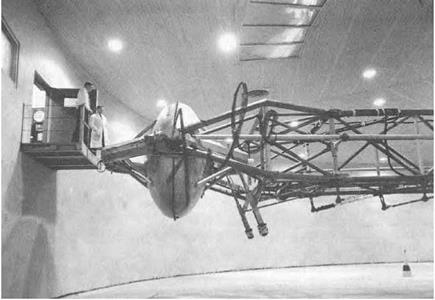Moving Base Cockpit and Centrifuge Simulators
As the computational capability to accurately model the handling qualities of an airplane improved, there was recognition that the lack of motion cues was a distraction to the realism of the simulation. An early attempt to simulate motion for the pilot consisted of mounting the entire simulator cockpit on a set of large hydraulic actuators. These actuators would generate a small positive or negative bump to simulate g onset, while any steady-state acceleration was washed out over time (i. e., back to 1 g). The actuators could also tilt the simulator cockpit to produce a side force, or fore and aft force, on the crew. When correlated with a horizon on a visual screen, the result was a quite realistic sensation of motion. These moving-base cockpit systems were rather expensive and difficult to maintain compared with a simple fixed-base cockpit. Since both the magnitude of the g vector and the rotational motion required were false, the systems were not widely accepted in the flight-testing community, where the goal is to evaluate the pilot’s response and capabilities in a true flight environment. They found ready acceptance as airline procedures trainers when the maneuvers are slow and g forces are typically small and proved a source of entertainment in amusement parks, aerospace museums, and science centers.
In the 1950s, the Naval Air Development Center (NADC) at Johnsville, PA, developed a large, powerful centrifuge to explore human tolerance to high g forces. The centrifuge consisted of a 182-ton electric DC motor turning a 50-foot arm with a gondola at the end of the arm. The motor could generate g forces at the gondola as high as 40 g’s. The gondola was mounted with two controllable gimbals that allowed the g vector to be oriented in different directions for the gondola occupant.[728]
|
Test pilot entering the centrifuge gondola at the Naval Air Development Center (NADC) in Johnsville, PA. NASA. |
Many detailed studies defining human tolerance to g forces were performed on the centrifuge using programmed g profiles. NADC devised a method for installing a cockpit in the gondola, connecting it to a large analog computer, and allowing the pilot to control the computer simulation, which in turn controlled the centrifuge rotation rate and gim – bal angles. This allowed the pilot in the gondola to not only see the pilot displays of the simulated flight, but also to feel the associated translational g levels in all three axes. Although the translational g forces were correctly simulated, the gimbal rotations necessary to properly align the total g vector with the cockpit were artificial and were not representative of a flight environment.
One of the first applications of this closed-loop, moving base simulation was in support of the X-15 program in 1958. There were two prime objectives of the X-15 centrifuge program associated with the high g exit and entry: assessment and validation of the crew station (side arm controller, head and arm restraints, displays, etc.), and evaluation of the handling qualities with and without the Stability Augmentation System. The g environment during exit consisted of a forward acceleration (eyeballs-in) increasing from 2 to 4 g, combined with a 2 g pullup (eyeballs-down). The entry g environment was more severe, consisting
of a deceleration (eyeballs-out) of 3 g combined with a simultaneous pullout acceleration of 6 g (eyeballs-down).
The results of the X-15 centrifuge program were quite useful to the X-15’s overall development; however, the pilots felt that the centrifuge did not provide a very realistic simulation of an aircraft flight environment. The false rotational movement of the gondola was apparent to the pilots and was a distraction to the piloting task during entry. T he exit phase of an X-15 flight was a fairly steady acceleration with little rotational motion, and the pilots judged the simulation a good representation of that environment.[729]
The NADC centrifuge was also used in support of the launch phase of the Mercury, Gemini, and Apollo space programs. These provided valuable information regarding the physiological condition of the astronauts and the crew station design but generally did not include closed-loop piloting tasks with the pilot controlling the simulated vehicle and trajectory.
A second closed-loop centrifuge simulation was performed in support of the Boeing X-20 Dyna-Soar program. Dyna-Soar constituted an ambitious but feasible Air Force effort to develop a hypersonic lofted boost-glider capable of an orbital flight. Unfortunately, it was prematurely canceled in 1963 by then-Secretary of Defense Robert S. McNamara. The Dyna-Soar centrifuge study effort was similar to the X-15 centrifuge program, but the acceleration lasted considerably longer and peaked at 6 g (eyeballs-in) at burnout of the Titan III booster. The pilots were "flying” the vehicle in all three axes during these centrifuge runs, and valuable data were obtained relative to the pilot’s ability to function effectively during long periods of acceleration. Some of the piloting demonstrations included alleviating wind spikes during the early ascent phase and successfully guiding the booster to an accurate orbital insertion using simple backup guidance concepts in the event of a booster guidance failure.[730] The Mercury and Gemini programs used automatic guidance during the ascent phase, and the only piloting task during boost was to initiate an abort by firing the escape rockets. The Apollo program included a backup piloting mode during the boost based on the results of the X-20 and other centrifuge programs.











